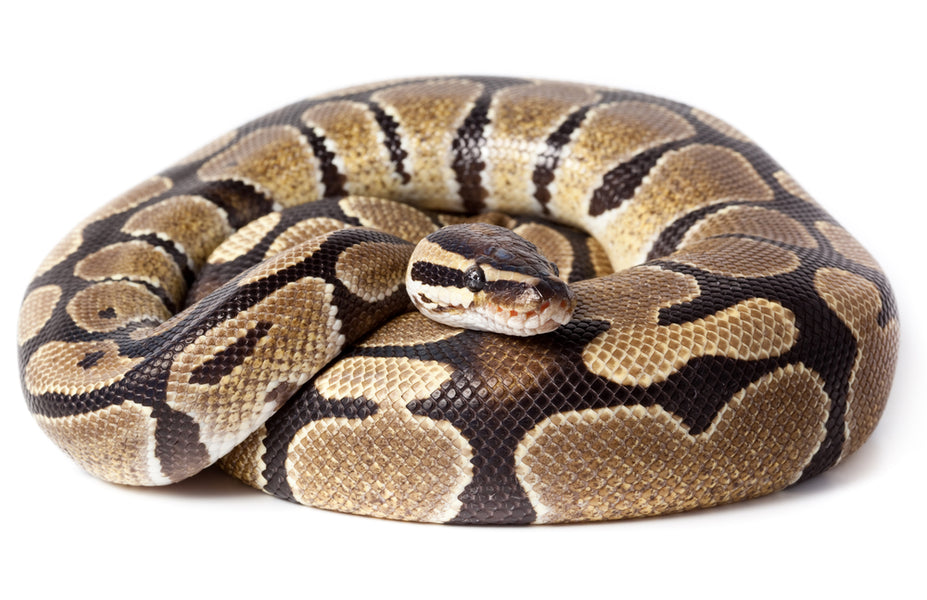Ball Python Care Sheet provided by ReptiFiles

Ball Python Care Sheet Provided by Reptifiles
Ball pythons are a terrestrial species of constricting snake native to regions of eastern, central, and western Africa. In the wild, they are most often found in semi-arid grasslands, sparse woodlands, fields, and near agricultural areas, sheltering in burrows, termite mounds, and hollow logs.
These snakes are crepuscular, which means that although they are active at night, they are most active around dawn and dusk. Being carnivorous constrictors, they use this time to hunt prey such as rodents and birds, using their powerful muscles to squeeze prey until it passes out (which is actually fairly humane and occurs within seconds).
Male ball pythons typically grow 2’-3’ long, while females grow to be 3’-5’ long. Larger individuals have been recorded. These snakes reach adulthood in 3-5 years and have a 15-30 year lifespan in captivity.
Ball pythons are very common in the pet trade due to morph breeding, which is the practice of breeding a reptile to produce colors and patterns not found in nature. At the moment, there are about 6500 known morphs.
These snakes make good pets due to their docile temperaments, slow movement, and manageable size.
Shopping List
- Meridian 4’x2’x2’ Zen Habitats Reptile Enclosure with PVC Panels
- 100w PAR38 halogen flood bulb, white light
- Domed heat lamp with a ceramic socket
- plug-in lamp dimmer
- 22” 5.0 T5 HO fluorescent UVB lighting + fixture
- light timer
- substrate (bedding)
- sphagnum moss
- large water bowl
- 2+ hides/caves (Zen Cave or Zen Corner Cave)
- temp gun
- digital thermometer/hygrometer
- decorations: thick branches, artificial plants, cork logs, rocks, etc.
- 12” soft-tipped feeding tweezers
Terrarium Size
Keep in mind that larger is always better! There is a common myth that ball pythons prefer smaller spaces, but this is not true and promotes obesity as well as decreases the snake’s overall quality of life. The minimum enclosure size recommended by modern ball python experts is 4’x2’x2’. It's best to choose a front-opening enclosure with a covered top, which makes accessing the snake much easier (and less startling for the snake). Multiple ball pythons should not be housed together.
Lighting, Temperatures & Humidity
Lighting Since ball pythons are crepuscular, they benefit from having a light in their enclosure to regulate their day/night cycle. There is a common misconception that snakes do not “need” UVB and therefore shouldn’t have access to it. However, there is mounting scientific evidence that UVB is, in fact, beneficial, and should be used. For this reason we recommend the Zoo Med T5 HO ReptiSun 5.0 or Arcadia Forest 6% for ball pythons, long enough to cover about 1/2 of the enclosure. Do not use other brands — when it comes to UVB, brand matters! In a 24” tall enclosure, it is best to install the UVB fixture under the mesh instead of over it, as the mesh will block a significant portion of the UVB light and your snake may not get enough. This can be done most easily with zip ties. Temperatures Because ball pythons are reptiles, they are cold-blooded, and that means they need a range of temperatures within their enclosure so they can regulate their own body temperature as needed. The warm side should be between 90-95°F and the cool side should be between 75-80°F. Place one of the hides directly under or near the heat lamp for best results. Many snake keepers recommend heat pads, but this is an outdated practice. White light heat lamps are more effective because they best mimic the effects of the sun in a ball python’s natural habitat. We recommend using a heat bulb like the Philips 100w PAR38 Halogen Flood Heat Bulb in a dome heat lamp and plugged into a lamp dimmer so you can control it if it gets too hot. The most accurate way to keep track of your terrarium temperature gradient is to use a temperature gun. They’re super reliable and essential for monitoring surface temperature, which is the temperature that your ball python will be feeling on the ground. Humidity Ball pythons need humid air inside their terrarium in order to keep their lungs healthy and to be able to shed their skin safely. To be specific, they need 55-65% ambient humidity. A large water bowl will help, but regular misting with distilled water in a pressure sprayer like the Exo Terra Mister is recommended. It also helps to have a “humid hide” lined with damp sphagnum moss to act as the most humid place in the enclosure. This sphagnum will need to be replaced about once a month. If that is not enough, we recommend mixing water into the substrate as needed. The air should be allowed to dry out between treatments. You can keep track of humidity levels with a digital hygrometer like the Zoo Med Digital Thermometer Humidity Gauge. Please note that the thermometer function on this device does not replace the need for the temperature gun.
Ball Python Care

Ball Python Tips From Zen Animal Care Manager

Beardie Tips from Zen Habitats Animal Care Manager

Corn Snake Tips from Zen Animal Care Manager
Other Pet Care




 Log in
Log in



